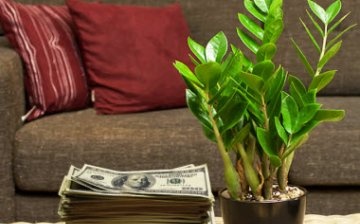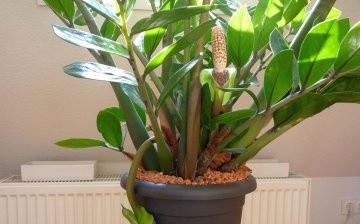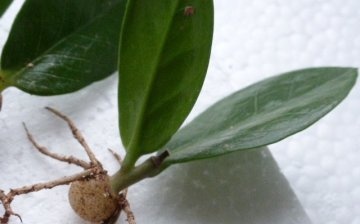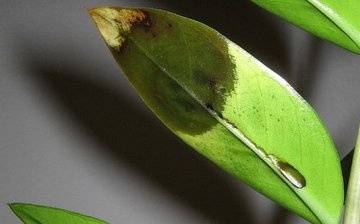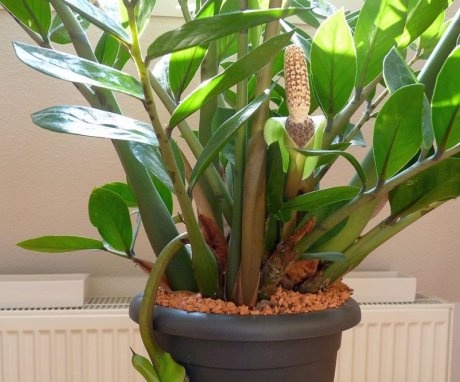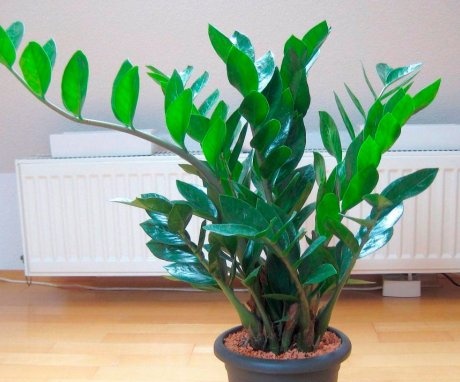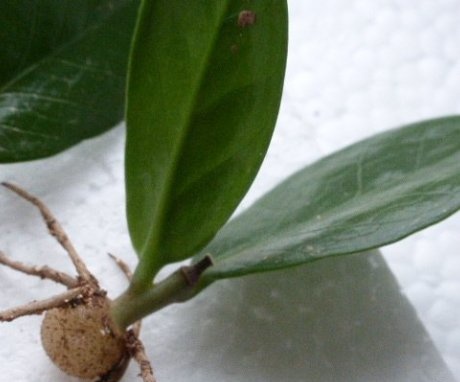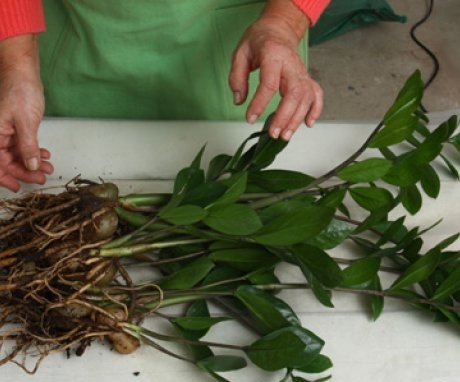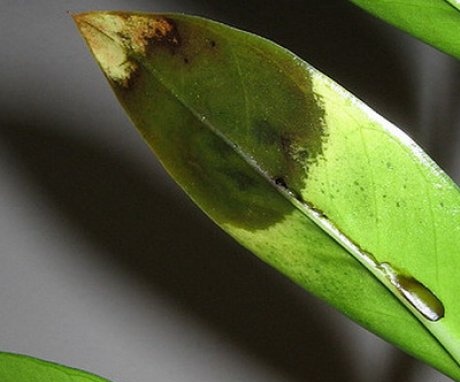Zamioculcas - "dollar tree" in your home
Exotic arrived zamioculcas from tropical African countries. The flower owes its official name to the southern plant of zamia, which is very similar. According to legend, the plant is capable of preserving and increasing the existing cash savings. But for this it must grow on the southeast side of the room and be absolutely healthy. The dollar tree has gained immense popularity among flower growers and amateurs, and you can admire this miracle not only in apartments, but also in office premises.
In nature, there are several varieties of zamiokulkas - lanceolate and Boivin. True, the second variety is no longer considered a zamiokulkas, but is considered a different type of plant. The lanceolate zamioculcas is common in Mozambique and has long lanceolate leaves (hence the name). In Russia, domesticated miniature species (up to 60 cm) of this plant, namely the "Zamicro" variety, which in natural conditions could grow up to a meter in height, became widespread.
Content:
- Features of zamioculcas
- Ensuring optimal conditions
- Reproduction and planting
- Some secrets of leaving
- Diseases and pests
Features of zamiokulkas
The plant will look good in tall, spacious flowerpots. The flower grows rather slowly and can multiply by twigs, cuttings or by dividing the tuber. The flower has dense rich foliage. There is a waxy coating on the surface of the leaf plate. The foliage of the plant is erect and is located on sturdy petioles.
But the dollar tree does not often please with flowering and the inflorescences have an interesting structure:
- It looks like an ear, strewn with many flowers, and in the upper part they are male, and in the lower part they are female.
- In the central part there is a zone with sterile flowers.
- The inflorescence is covered with an unusual leaf of a pale greenish hue, which is commonly called a veil.
- The length of this leaf ranges from 5 to 8 cm.
The inflorescence is located near the root, rising above the ground by three to four centimeters. Initially directed upward, and as it matures, it bends to the soil. The seeds are not capable of ripening at home, which excludes seed reproduction.
In the natural habitat of zamiokulkas, the climate is characterized by abrupt changes in seasons: from tropical torrential downpours to dry sultry periods.
Arriving at unfamiliar latitudes with completely different climatic conditions, the plant was forced to adapt. Zamioculcas learned to accumulate moisture in leaf petioles, roots and tubers. It is because of this adaptability that the flower of indifference is completely unpretentious in care, which attracts many amateur gardeners.
Another feature of the dollar tree is its connection with many signs:
- If a girl starts a tree in the house and it blooms, then the owner will acquire female happiness.
- You cannot give away the shoots of a plant for nothing, you need to take a small coin in return.
- To successfully accumulate "green" currency, you need to place a one dollar bill on the plant.
- Experienced florists claim that the flower will bestow upon its owners if the location is chosen according to Feng Shui.
Ensuring optimal conditions
Zamiakulkas is ideal for living in modern apartments. In winter, due to heating, the air in the room is dry, which creates a special microclimate for the successful development of the flower.
The plant equally likes sunny and shaded areas of the room, but you should not forget about watering.
The optimum temperature is considered to be 25-30 degrees in summer and about 13 degrees in winter. There is no need for regular spraying, just occasionally you should arrange light water procedures for the plant for the purpose of hygiene.
It must be remembered that excessive humidity and low temperatures can cause illness and even the death of a tropical friend.
Reproduction and planting
Any ready-made soil mixture for succulents is suitable for planting a flower of indifference. It should be loose, allow air and moisture to pass through and have low acidity. But zamiokulkas categorically does not tolerate stagnant moisture, so you need to take care of the availability of high-quality drainage, for which expanded clay or gravel is used, sprinkled on top with a layer of sand. Such a "sandwich" should occupy at least a quarter of the planting capacity.
In all types of work with the plant, care should be taken and personal protective equipment should be used so that poisonous juices do not get on the skin.
Several methods are used for reproduction:
- With a piece of paper. For this method, young medium-sized leaves are separated, the sections of which must be treated with crushed charcoal or activated carbon. The leaves are given time to dry by placing them in a dry place for several hours. Then they are planted in sandy peat soil. You can cover the top with a plastic bag and place in a warm place. After the appearance of the first roots, leaves transplanted to a permanent place.
- Cuttings... Most popular. A young shoot is separated from the mother plant and transplanted into an individual container directly into the soil, consisting of peat and sand, in equal proportions. You can create greenhouse conditions for the plant by covering the stalk with a jar. The best period for propagation by cuttings is considered to be the end of spring.
- Tuber division. It is rarely used, due to the slow growth of the flower. During the transplantation of an adult plant, the underground part is divided into several parts and simply seated in separate pots. However, it should be borne in mind that the root system of the zamiokulkas is very delicate and reacts poorly to mechanical damage.
Don't count on the rapid growth of the dollar tree. Throughout the year, the flower has only 2-3 leaves. Therefore, the process of growing, especially from a leaf, will require a lot of patience from the owners.
Some secrets of leaving
Zamioculcas does not require special care. All he needs to feel comfortable is regular irrigation and adequate lighting. If necessary, you can feed the plant.
When watering a dollar tree should adhere to the basic rule: underfilling is better than overflowing, since the flower accumulates a sufficient amount of moisture in the ground and underground parts. Irrigation features are as follows:
- the next watering should be carried out only when the upper part of the earth dries well and will easily crumble in the fingers
- winter watering is greatly reduced and carried out at intervals of one to two months
- in the summer, watering the plant is enough once every seven days, but observe the condition of the soil and prevent the earthen coma from drying out too much
- it is necessary to provide high-quality drainage to protect the roots from rotting
- do not water the flower with cold water. Water for irrigation should settle and warm up to room temperature
In too hot weather, the leaves of zamiokulkas should be wiped with a damp cloth or cotton pad, sometimes they can be lightly sprayed. After such procedures, you should not allow direct sunlight to hit the plant in order to avoid burns.
It is often not worth feeding zamioculcas.
It is enough to add half of the recommended feeding rate intended for cacti and succulents or for decorative leafy flowers once a month, during the period of active development, from April to August. So as not to burn root system, fertilizer should be applied the next day after watering. Since September, feeding is stopped.
Optimal terms for transplants the dollar tree is considered spring or summer. The frequency of the transplant is 2 - 4 years or on request. The planting capacity must be selected according to the size of the roots, because in a large container the soil can acidify, which leads to diseases... Adult plants are transplanted less often with partial replacement of the land. It is important to ensure that the earthen ball is not damaged, otherwise fragile roots can be injured. However, if there are traces of root decay, then they should be removed with scissors so that the rot does not spread to healthy fragments.
Diseases and pests
Zamioculcas is rarely exposed diseases and insect attacks. The plant has high endurance and the reasons for poor health lie in the gross mistakes made when leaving:
- Decay of roots. The reason is excessive watering or lack of good drainage. You can reanimate the plant through timely transplantation, while removing damaged roots. The rest of the roots must be treated with chopped charcoal and dried. Plant the plant in new soil and reduce the amount of watering.
- Leaves turn yellow... It is not a disease if the attack is not spread throughout the flower. Such changes occur due to the natural change of leaves, when young leaves grow to replace the old ones. If new shoots are growing, then there is no reason for concern, and if there is no growth, then the cause of this condition should be identified - the flower can be attacked by pests, insufficient watering, or the plant is subject to constant drafts. To cure the plant, it is enough to eliminate the causes of the ailment.
More information can be found in the video:
Houseplant pests:
- Spider mite. It can move to zamioculcas from infected plants. At the same time, an accumulation of pests is observed on the inner side of the leaf plate, and the plant itself slowly dries up and becomes covered with a sticky cobweb. To kill insects, tobacco solution, ground sulfur and systemic insecticides are used.
- Shield. When infected, it begins to actively spread along the stems and leaves of the plant, showing its presence by the formation of dark spots.
- Aphid... It lives on the inside of the leaves and sucks the juices from the plant. As a result of the active vital activity of insects, the plant dries out, and the leaves curl and fall off.
For effective control of parasites, systemic insecticides and traditional methods in the form of soap and tobacco solutions should be used.
Zamioculcas does not require special conditions of detention and is quite common not only in residential but also in office premises. The flower is able to fit into any interior, bringing the spirit of the era of dinosaurs. However, beauty is not the only thing that attracts flower growers in it. The incentive to acquire it is the ease of care and belief in increasing wealth.



